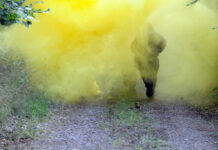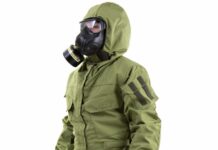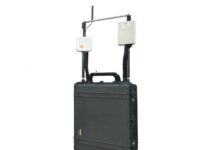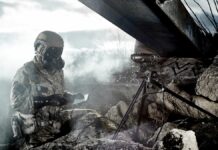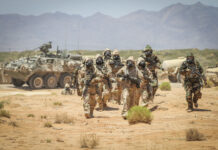There is a distinction between military CBRN protective clothing and civilian-sector hazardous materials protective clothing for use in industrial safety and emergency services operations. The latter are designed with different roles and risk assessments in mind. Although there is some overlap in the two market segments, this article covers the military market.
CBRN protective clothing is an important component in protection of military personnel from CBRN hazards. For the most part, CBRN protective clothing is chemical protective clothing as the nature of the chemical warfare agent threat becomes the key design criteria as it is chemical agents that comprise the principal threat to skin.
Protection vs. Heat Stress
Design of CBRN clothing is based on battlefield missions and environments that soldiers work in, balanced with the ability to protect against the most pernicious of the chemical threats – blister and nerve agents. As such, military chemical protective clothing is always a compromise between safety (preventing the hazard from affecting the soldier) and allowing the soldier to operate on the battlefield. The general trade-off is between chemical protection versus heat stress. The best barrier material (plastics and rubbers) also provide a high level of heat stress that might end up killing and injuring more soldiers than any chemical attack would. The history of CBRN defence has been, in part, a history of developing clothing that tries to find the right compromise. In the last 50 decades, chemical protective clothing has become more advanced, less burdensome on the wearer, and often more expensive.
One way to examine this subject is to do a historical cross-section, using the USA as an example. The US market has long driven this area. The US Army’s experience is broadly similar to those of the major European militaries.
Non-Permeable Suits
The oldest approach to military chemical protective clothing was non-permeable suits that protected by forming an impermeable barrier. In the 1960s, the M3 Toxicological Agent Protective Suit (TAP) was an extensive set of butyl rubber and rubber-coated textiles. It was a full suite of items that took half an hour or longer to don and was intended for serious chemical defence tasks like decontamination. In hot weather, it would have been as deadly to wear as the agents it was protecting against. It (and its even less pleasant Soviet equivalent – still serving in places) was not a tool for a warfighter. The TAP apron, though, lives on in the US Army Chemical Corps in decontamination duties.
Permeable Protective Clothing
Most major western militaries started the gradual shift towards permeable protective clothing and getting away from the harder impermeable barriers. Butyl rubber and similar materials are still frequently found in boots and gloves. From the 1970s onward, the idea caught on that permeable suits which could safely absorb or adsorb chemical hazards while allowing some heat and moisture to escape would be more wearable by soldiers in wartime conditions. This was true, up to a point. Heat stress was (and still is) a serious issue, but it became possible for the rank and file to wear protective clothing.
Charcoal Suits
The US Army had a suit called the “Chemical Protective Overgarment” (late 1970s-early 1990s) and its successor the “Battle Dress Overgarment” (late 1980s-late 1990s). These use activated charcoal in a layer between inner and outer textile layers. The idea was that these “charcoal suits” as they became known, would absorb or adsorb droplets and vapours of nerve and blister agents. They were quite effective and could be worn for days or even weeks before they lost their effectiveness. The UK’s equivalent, the Mk4 suit, with its carbon-impregnated felt layer was very similar.
The Gulf conflicts in the early 1990s used up much of the inventory of the West’s Cold War-era charcoal-based suits and in doing so demonstrated that the existing suits were still too hot. Charcoal suits, while they still exist, have largely been supplanted, from the 1990s onward by more advanced, breathable textiles. Many of these are quite proprietary in design. Pushed heavily by the US DoD Joint Service Lightweight Integrated Suit Technology (JSLIST) procurement effort, new textiles came into service.
JSLIST Suits
JSLIST suits and their equivalents in other countries replace bulk charcoal or carbon with small spheres of adsorbent carbon embedded in the actual fabric. This results in a lighter fabric with less heat stress. The suits themselves are even launderable a number of times, resulting in the ability to stretch a stockpile of them further in actual operations.
The author has direct operational experience over the course of this broad arc of development and can attest that the JSLIST-era suits, which came into service in the late 1990s, are indeed a more comfortable item. Blücher (Germany) and its subsidiary Tex-Shield (USA) are examples of manufacturers of this technology. A key manufacturer in the space, Remploy (UK) no longer makes such suits, but OPEC Systems (UK) has picked up the former Remploy product line in this space. Paul Boye (France) is also a key player in this space. A number of smaller players serve national markets.
The great rival to such technologies is Gore, famous worldwide for its “Gore-Tex” waterproof garments and fabrics. W.L. Gore and Associates (USA) have adapted their technology to CBRN defence. Their “ChemPak” technology uses selectively permeable membranes to let air in, moisture out, and prevent chemical hazards from passing through the garment.
Room for Improvement
CBRN protective clothing is clearly an area where there is room for improvement. The ideal – a CBRN suit that is, in effect, as easy and cheap to wear as a regular combat uniform – still eludes industry. But we are not actually all that far off. Current CBRN suits are more burdensome than, say, 1980s-era US Army BDUs, but not by a massive margin.
Significant scientific and technical efforts are underway to provide the next generation of CBRN protective clothing and textiles. The next great generational improvement in the US military is one that will also cascade into the USA’s allies. This is both directly through foreign military sales and indirectly through manufacturers having the new products in their catalogues and product lines. JSLIST is being replaced by the Uniform Integrated Protective Ensemble (UIPE) family of products. UIPE has a long history, with millions having been spent over the last decade. Gore and Paul Boye, among others, have participated in the UIPE effort. Currently, military aircrew versions of the UIPE are being tested in operational environments by the US Air Force in Texas.
Outlook
Beyond the UIPE, where is the future in this field? Some new products will no doubt emerge from the existing technologies in the form of incremental improvements.
New materials and new textiles continue to be invented for various purposes, which could be adapted to CBRN protective clothing. One approach may be to get beyond barriers, permeable or otherwise, and beyond adsorption. Is it possible for clothing to actually neutralise chemical warfare hazards? Recently published research in the journal ChemCatalysis looks very promising.
A research project on “metal organic frameworks” done by the US Army and Northwestern University show that it is possible to make a hydrogel that can neutralise nerve agents. This hydrogel can actually be integrated into a layer of cotton cloth in a uniform or protective suit. While protection against nerve agents is only part of the threat, perhaps multiple hydrogels could be developed so that blister agents could be addressed as well.
Using the same tactic, DARPA is funding work into “Personalised Protective Biosystems.” This programme wants to look into embedding catalysts (of which the hydrogel work above is only one approach) into suits, clothing, and gloves. These catalysts could neutralise chemical threats. FLIR (USA) has been awarded a US$20M contract on this project.
We do not know what the CBRN textiles of the future will look like. Will they be an advanced “Gore-Tex” type material? Or a regular duty uniform treated with special substances? Or some combination thereof? This is a market segment that bears watching.




